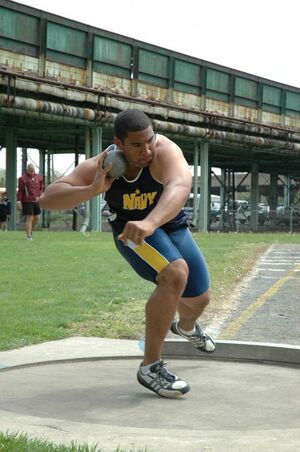The Shot Put
Original Editor - Matt Huey
Top Contributors - Matt Huey and Kim Jackson
Introduction[edit | edit source]
The shot put is an event in which the participant stands inside a circle and attempts to "put" a weighted ball as far as they possibly can. The "put" is different than a "throw" due to the motion of the arm. it has a history back to ancient times when people threw rocks for distance. During the Middle Ages, competitions on who could throw a cannonball the furthest has been recorded.
Currently, the shot put is thrown both during indoor and outdoor track and field seasons.
The shot[edit | edit source]
The shot itself will vary in weight, depending on the level of competition and between men and women. Women will use a 4 kg (8.81lb) shot from high school to college/Olympic level. Men at the high school level will use a 12lb (5.44kg), Junior competitors 14lb (6.35kg) and then at college/Olympic level 16lb (7.25kg).
All competitors stand in a circle that is 7 feet (2.135 m) in diameter that has a 10cm toe board at the end. Competitors put the shot into the "sector" which is a partial circle of 34.92 degrees from the center of the throwing circle. Competitors are allowed to standing anywhere in the circle and move through the circle before putting the shot into the sector.
Rules[edit | edit source]
- Competitors cannot enter the circle until their name has been called
- The competitor must place the shot against their neck and it must stay there until it is released
- Once the shot has landed in the sector the command "mark" is given to which the competitor exits the shot
- A measurement is recorded from the inside of the toe board to the mark at which the shot landed
Fouls are called if the competitor performs any of the following violations
- Enters the ring before name being called
- The shot coming away from the neck before the release
- Any portion of the competitor (including clothing) touching the top or outside of the ring or toe board
- Exiting the ring before the "mark" command
- Exiting the ring from the front half of the circle
Techniques[edit | edit source]
Two techniques are most commonly used: the glide or the spin
The Glide[edit | edit source]
The competitor stands backwards at the back of the ring. For a right handed thrower, they stand more on the right foot then bend down at the hips and knee with the left back. They then pushes the left backwards toward the toe board and land on the right foot. This performs the "glide" motion across the ring. Once at the front of the ring, the competitor pushes from the rear leg, rotating forward, and putting the shot into the sector. This technique was developed by Parry O'Brien.
The Spin[edit | edit source]
The competitor stands facing backwards in the ring but in a more balanced stance. For a right handed thrower, they then rotate on the left foot toward the front of the circle. The right foot lands in the middle of the ring, then the left leg comes through to the toe board. They then put the shot into the sector. This technique was developed by Viktor Alexeyev.
Records[edit | edit source]
The current world records are:
| Type | Athlete | Distance |
|---|---|---|
| Men's Indoor | Ryan Crouser | 22.82 m (74 ft 10.25in) |
| Men's Outdoor | Ryan Crouser | 23.37 m (76ft 8in) |
| Women's Indoor | Helena Fibingerova | 22.50 m (73ft 9.75in) |
| Women's Outdoor | Natalya Lisovskaya | 22.63 m (74 ft 2.75in) |
Common injuries[edit | edit source]
For the shot put, injuries to the rotator cuff can be common due to the stresses applied to the shoulder for the putting motion. Due to the explosive nature of the release, pectoral strains can occur. There can also be injuries to the hand and finger due to the release of the shot. Knee injuries can occur in athletes who utilize the spin technique due to the rotatory forces on the structures. Lastly, back pain can occur in shot put athletes due to the repetitive stress of the technique. [1]
References[edit | edit source]
- ↑ Meron, A., & Saint-Phard, D. (2017). Track and Field Throwing Sports: Injuries and Prevention. Current sports medicine reports, 16(6), 391–396. https://doi.org/10.1249/JSR.0000000000000416







